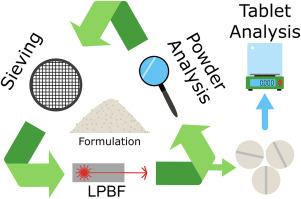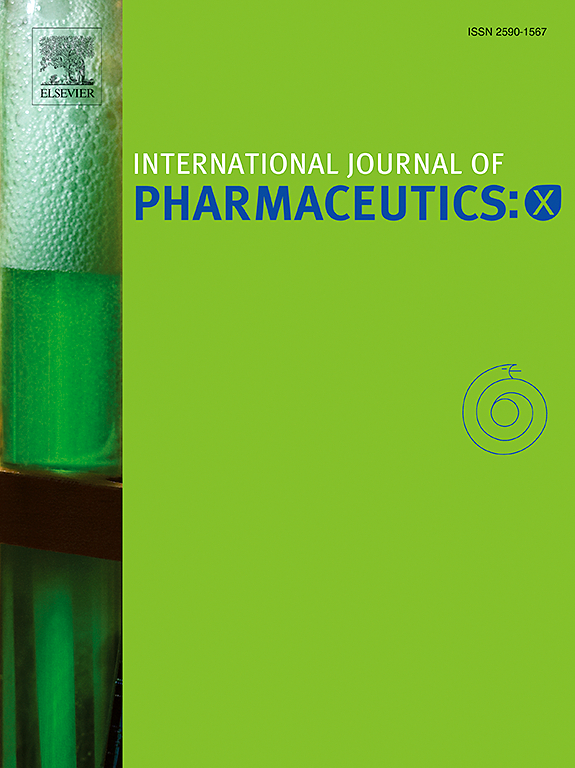激光粉末床熔融3D打印中药物配方回收的影响——物理现象对打印性能的影响
IF 6.4
2区 医学
Q1 PHARMACOLOGY & PHARMACY
引用次数: 0
摘要
激光粉末床融合是一种有吸引力的粉末床3D打印技术,并已被用于打印药物剂型,如片剂。未烧结残粉的回收利用尚不清楚,但对防止经济损失和提高该技术的可持续性至关重要。研究了三种药物制剂在片剂激光粉床融合工艺下的可回收性。由常见的药物聚合物和模型药物吲哚美辛组成的三种配方已经研究了10个印刷周期。对于每个印刷周期,收集粉末和片剂样品并分析老化现象。结果表明,聚乙烯醇和甲基丙烯酸-丙烯酸乙酯共聚物为基础的配方是可回收的,印刷剂型的关键质量属性分别在5和9 循环中没有变化。以copovidone为基础的制剂在10个 循环中显示颗粒大小逐渐增加,导致片剂重量逐渐减少。在本工作评估的条件下,该配方被认为是不可回收的。观察到的老化现象主要与颗粒大小、粉末黏聚力和玻璃化转变温度的变化有关。研究表明,在配方开发过程中考虑粉末老化对优化打印性能和进一步发展激光粉末床融合技术至关重要。本文章由计算机程序翻译,如有差异,请以英文原文为准。

The effects of recycling pharmaceutical formulations in laser powder bed fusion 3D printing - the influence of physical phenomena on printing performance
Laser powder bed fusion is an attractive technology for 3D printing objects in a powder bed and has been explored for printing pharmaceutical dosage forms, such as tablets. Recycling of non-sintered residual powder is not well understood, but is critical to prevent economic losses and improve the sustainability of this technique. We investigated the recyclability of three pharmaceutical formulations in the context of laser powder bed fusion of tablets. Three formulations consisting of common pharmaceutical polymers and the model drug indomethacin have been investigated up to ten print cycles. For each print cycle, powder and tablet samples were collected and analyzed for ageing phenomena. Results showed that polyvinyl alcohol and methacrylic acid-ethyl acrylate copolymer-based formulations were recyclable without changes in critical quality attributes of printed dosage forms for 5 and 9 cycles, respectively. A copovidone-based formulation showed a gradual increase in particle size over 10 cycles, resulting in a gradual decrease in tablet weight. This formulation was considered non-recyclable under the conditions evaluated in this work. The observed ageing phenomena were mainly related to changes in particle size, powder cohesion, and glass transition temperature. It is shown that considering powder ageing during formulation development is critical for optimal print performance and further development of laser powder bed fusion for pharmaceutical applications.
求助全文
通过发布文献求助,成功后即可免费获取论文全文。
去求助
来源期刊

International Journal of Pharmaceutics: X
Pharmacology, Toxicology and Pharmaceutics-Pharmaceutical Science
CiteScore
6.60
自引率
0.00%
发文量
32
审稿时长
24 days
期刊介绍:
International Journal of Pharmaceutics: X offers authors with high-quality research who want to publish in a gold open access journal the opportunity to make their work immediately, permanently, and freely accessible.
International Journal of Pharmaceutics: X authors will pay an article publishing charge (APC), have a choice of license options, and retain copyright. Please check the APC here. The journal is indexed in SCOPUS, PUBMED, PMC and DOAJ.
The International Journal of Pharmaceutics is the second most cited journal in the "Pharmacy & Pharmacology" category out of 358 journals, being the true home for pharmaceutical scientists concerned with the physical, chemical and biological properties of devices and delivery systems for drugs, vaccines and biologicals, including their design, manufacture and evaluation. This includes evaluation of the properties of drugs, excipients such as surfactants and polymers and novel materials. The journal has special sections on pharmaceutical nanotechnology and personalized medicines, and publishes research papers, reviews, commentaries and letters to the editor as well as special issues.
 求助内容:
求助内容: 应助结果提醒方式:
应助结果提醒方式:


